Quizzes are some of the most powerful lead generation devices out there – especially personality quizzes.
They make it possible to convert more than 30% of your visitors, increase engagement, and segment new email subscribers all at once.
It’s the best of all worlds.
What many people don’t realize is that there are many ways and types of quizzes and each one has a different use case.
Some quizzes are ideal for product recommendations while some of them are perfect for engagement and subscribers.
Personality quizzes fall into the second category.
In this post, you’ll learn how to create engaging personality quizzes that move you closer to the end goal – more email subscribers and customers.
Table of Contents
What is a personality quiz?
There are many different types of quizzes. Some quizzes are more of an assessment. If someone gets the answer right or wrong, they’ll get a specific score or grade.
Other quizzes test your knowledge about specific subject matter. For example, how much do you know about marketing? Or how much do you know about Game of Thrones? Depending on how they answer questions, you’ll assess their understanding of the topic.
In both of those examples, there’s a right and a wrong answer.
With a personality quiz, there’s no right or wrong answer because no one can have the wrong personality. What a personality quiz aims to achieve is shed light on the kind of person that’s taking the quiz and make recommendations based on it.
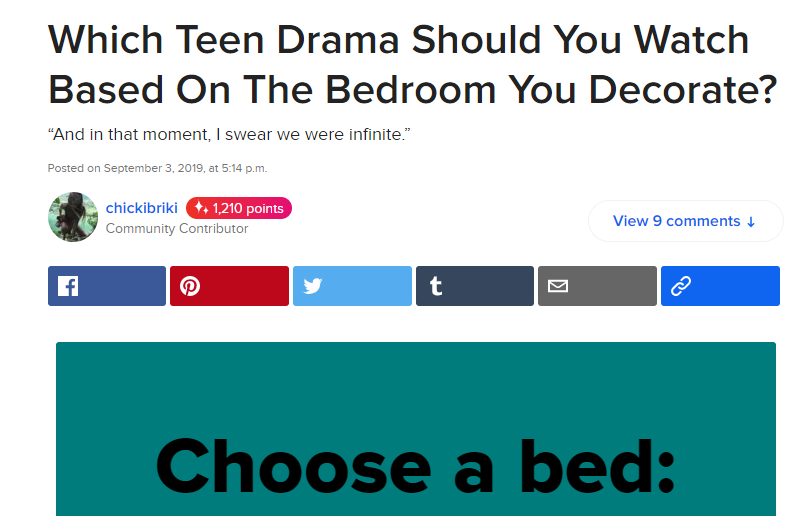
At its core, a personality quiz is designed to reveal something interesting about the quiz taker so they’ll want to share it with their network. This, in turn, gives you more exposure, leads, and social proof. It’s a self-perpetuating cycle.
Why do they work so well?
There’s a reason personality quizzes work and it has little to do with you and your brand. The real culprit is human psychology.
Dr. Robert Simmermon, a psychologist in Atlanta Georgia, says they’re so addictive because of our sense of unfolding story. This is an aspect of narrative psychology which postulates that humans make sense of the world and their lives by grouping events into a series of stories.
These stories fit together over time and essentially form our own biographies. This narrative is always evolving and gives credence or authenticity to us, our actions, and our position as the hero of our own story.
This happens subconsciously. Most people never realize they’re going through this process which is why quizzes are so powerful. When someone takes a personality quiz, the results can reinforce the internal narrative already happening.

This entire process is why Barnum statements are so powerful. You’re able to use general statements and apply them to specific situations. The person on the receiving end of those statements will interpret them how they see fit.
How to make a personality quiz
Now that you’re up to speed on what a personality quiz is and the psychology behind why they work, it’s time to create one. Not just any personality quiz, one that will be shared from one corner of the web to another.
The personality quiz topic is everything
Just like with a blog post, you can, quite literally, create a quiz about anything. That doesn’t mean you should.
The topic you focus on should be relevant to your target market. If you’re in the fitness space, you could create a quiz asking people “What Kind of Game of Thrones Character Are You?” While that may get you a lot of interest because Game of Thrones is so popular, will the people who take the quiz be interested the rest of your brand?
Probably not.
If you’re in the fitness space and create a personality quiz such as “What’s your ideal workout style based on your personality?” it may get less interest. That’s not a bad thing because you know the people who do take it are in your target market.
Savvy educators have discovered that turning assessment into a game-like experience dramatically increases student participation and enthusiasm for learning. When designing thoughtful questions, teachers naturally focus on core concepts that truly matter rather than trivial details that don’t serve long-term understanding.
The anticipation of being tested motivates students to engage more deeply with the material, transforming passive review into active learning through retrieval practice. Today’s digital tools make it ridiculously easy to create a quiz that not only handles the grading automatically but also generates insightful reports showing exactly where students are struggling and excelling.
There are two simple ways to come up with the right topics for your personality quiz
- Your own content
- The content of others
Your own content
You’ll take the most popular pieces of content and adapt them to make different personality quizzes.
Step 1: Log into your Google Analytics account (if you don’t have GA, it’s free and worth setting up)
Step 2: Choose the correct property (if you’re tracking more than one website) and click behavior > site content > landing pages.
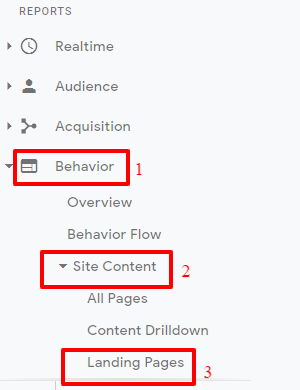
Step 3: Set a timeframe of six months to account for any spikes in traffic that may have happened. It’ll all even out over time.
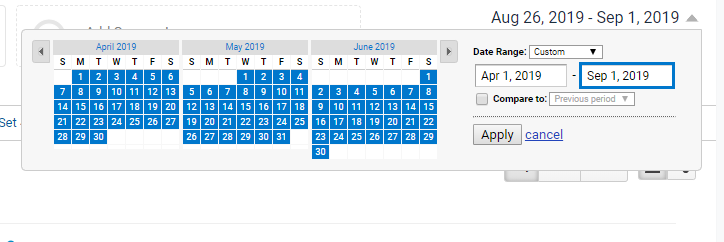
Step 4: Exclude your homepage and product pages to find your 10 most visited pieces of content.
Run them through Buzzsumo to see which ones are the most shared.
Adapt the top 3 (or however many you want) into quiz topics. As you can see, we’re not taking a stab in the dark, we’re using what your audience has shown you they resonate with to create the personality quiz.
The other strategy is to use the content of popular websites in your niche to find the perfect topic for your personality quiz.
Using the content of others
I’m sure you know the popular websites in your niche so I won’t focus on how to do market research to find them. Here’s how to use their popular content to choose a quiz topic.
Step 1: Navigate to buzzsumo.com
Step 2: Type in the URL of one of the popular websites in your niche

Step 3: Look through the results of the most popular content and see if you can adapt it to make a personality quiz.
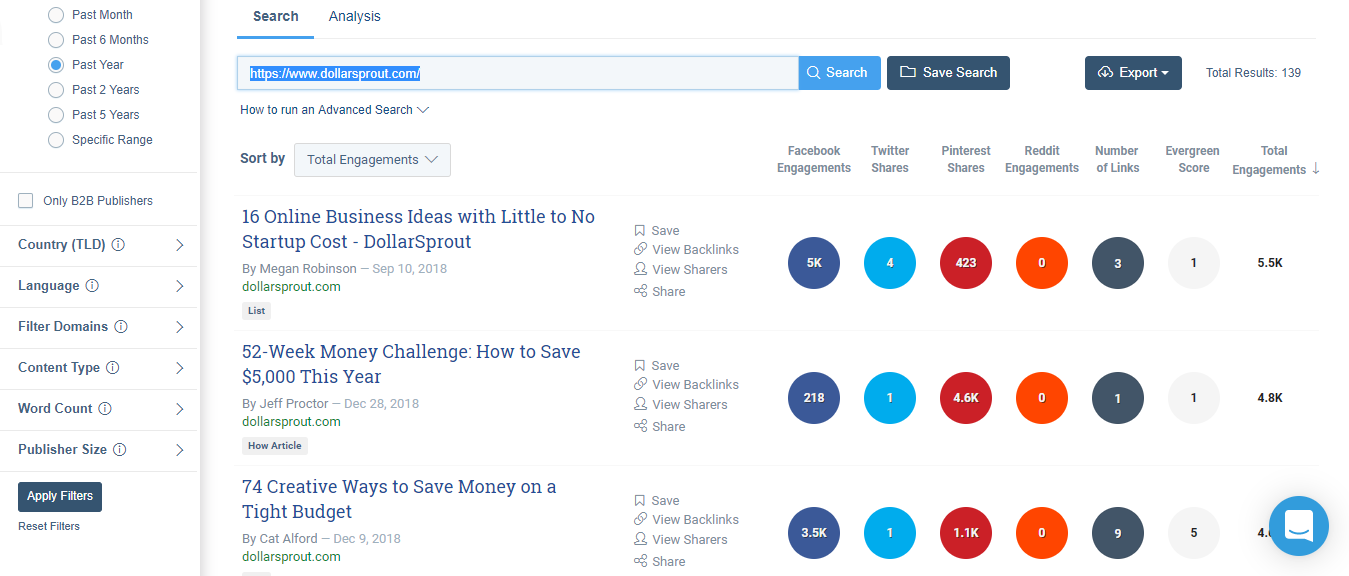
Step 4: Rinse and repeat with the other popular websites in your niche until you have a few personality quiz topics you think will work for your audience.
After settling on the right topic, it’s time to make outcomes that encourage sharing.
Creating the outcomes
It may seem like the questions are meant to come first. They’re not because each question and answer in a personality quiz is designed to move people to a specific outcome. It’s the outcomes that make your lead generation successful because if you get lazy here, your new contacts will unsubscriber or ignore you.
If you’re creating the questions first, the answer options aren’t designed to for your outcomes and one of two things can happen:
- There’s a disconnect between what a user answered and the outcome they get
- You have to go back and recreate the questions
Neither option is ideal.
That’s why we create outcomes first.
Moving on.
Your outcome is designed to do two things:
Use the information the quiz taker gave you to diagnose their problem or personality and also show them the next steps.
The next steps can be anything. A product recommendation, a course of action, signing up for a webinar, etc. It depends on you.
There are two ways to create an outcome with KyLeads. You can redirect quiz takers to a specific page on your website or you can create an outcome directly within the quiz builder.
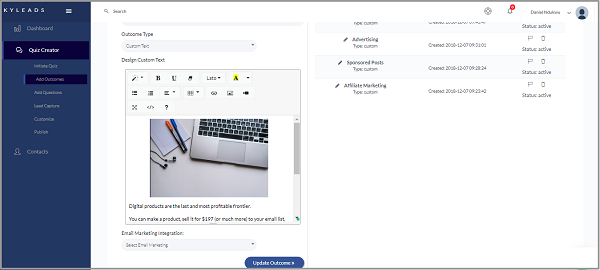
Both options are viable but setting up your social sharing is easier from within the quiz builder. Whatever route you choose, there are certain elements each outcome should have.
- Compelling imagery
There are two types of images you can use in the outcome. You have your featured image and you have additional imagery inside the outcome itself. This is found within the outcome itself.
The first image quickly communicates what the outcome is all about. The other images help your quiz taker better understand the outcome they’ve gotten.
Think of it as a blog post. You have featured images and other images that help you drive your point home and illustrate what you’re talking about.
- Relevant outcome text
After you’ve decided on a relevant series of images (or at least the featured image), next comes the outcome text. This can also be a video.
Many people drop the ball here because they want to write 50 words and call it a day. After all, they’re only interested in the leads they’re generating. While this can technically work, it can leave a bad taste in the mouths of your audience.
They took a few minutes to go through your quiz and the outcome wasn’t relevant to them. Do you think they’ll pay attention to your follow up emails and offers or even share the outcome they got?
Not likely.
The most effective outcomes are at least a few hundred words long and have two parts. The first part is where you talk about their answers and what it means for their personality.
Incorporate what you know about your audience here while using Barnum statements.
The second part is where you present a CTA for them to take the next steps.
- A CTA moving them to the next step
This can be anything that makes sense for your business but it has to be relevant to the quiz. After you’ve used Barnum statements to present their outcomes, what should they do next?
How can they take advantage of the new insights they’ve gained?
You prescribe a solution and show them how to take the next steps.
For example, if you found out that their marketing personality is publish and pray, you could present a simple product that helps them get more organized with distribution.
What kind of products and services do you have that can tie into the outcome or would make sense to be the next step? This is a front end offer so it shouldn’t be too expensive.
Up next are the questions.
Write compelling personality quiz questions
Note: we’ve written extensively on quiz questions here so I’ll just highlight the main points for you. Be sure to read the article I just linked.
Keep in mind that personality quizzes are informal. Even if your brand isn’t adventurous, it’s a rare opportunity for you to loosen up.
Ask questions using words and phrases your target quiz taker would use naturally. If they would use contractions then you use contractions. If they describe carbonated water with food coloring as soda or pop then describe it the same way.
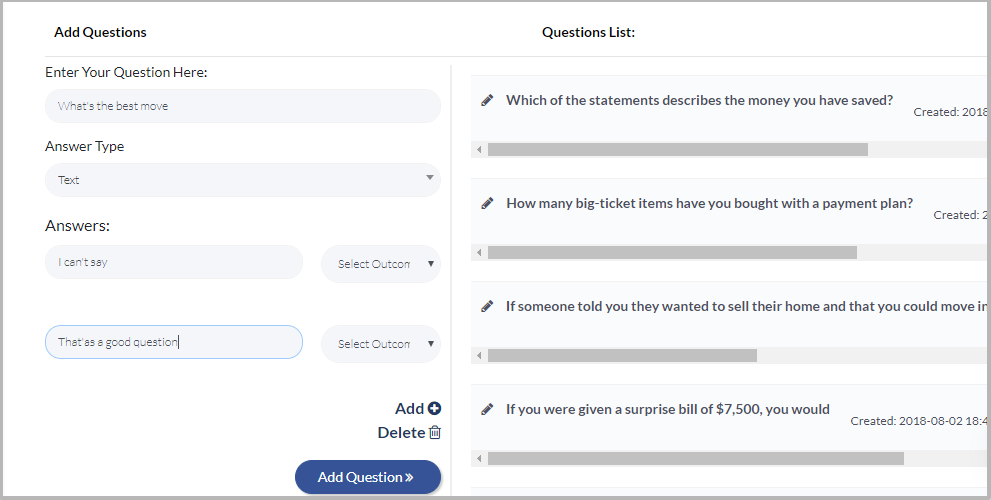
Here are a few other things to keep in mind:
- Start with an easy question and end with an easy question
- Keep it between 7-10 questions
- Incorporate your brand personality
- Use simple language and avoid being “clever”
- Keep your target user in mind
Those are the most important aspects of creating a compelling set of quiz questions. The most important thing is to make sure they match your outcomes so there’s no disconnect.
Make a compelling lead capture page
This is the fun part – generating email subscribers.
It can also go wrong.
Why?
Because simply telling quiz takers to enter their details to get their results isn’t ideal. This may work and oftentimes, it works better than a site wide popup.
We’re not looking for incremental improvements. We’re looking for 20% – 40% conversion rates on our quizzes. That’s not possible when you don’t give an incentive that goes beyond just telling people to sign up to get results.
Here are a few things you can do to create a better offer at the point of lead capture:
- An email course based on their outcome
- A cheatsheet
- A guide
- A checklist
- Etc.
So yes, you tell them that they need to submit their email address to get their results but you also layer on an extra reason.
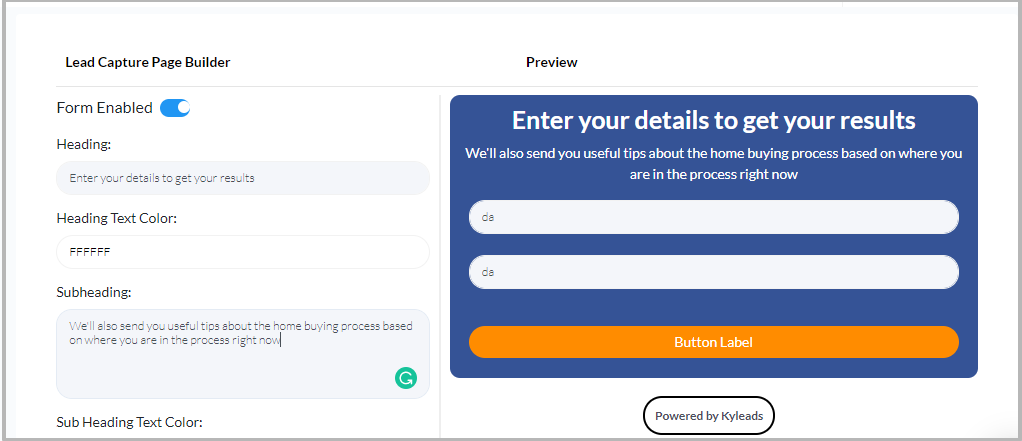
Within the KyLeads quiz builder, that’s as simple as adding a heading and subheading. Since each outcome has a unique mailing list or tag applied to it, set up your email marketing service to deliver a lead magnet or whatever the incentive was depending on the outcome they got.
Conclusion
Personality quizzes are a powerful way to generate leads, understand your audience, and engage with your current subscribers. It’s also easy to get wrong and not see the results promised.
This post has gone through the process of creating a quiz from choosing a topic to building the lead capture page. Out of everything, the topic is the most important.
Go through the process outlined here starting with your topic to create a compelling personality quiz.
Let me know what you think in the comments and don’t forget to share.